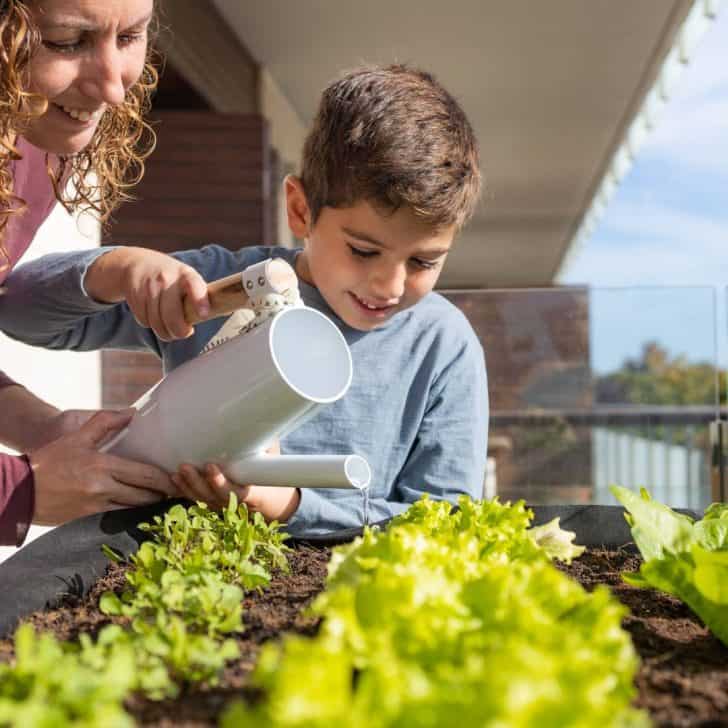A balcony vegetable garden is the perfect solution to having fresh and tasty produce right at your fingertips without using a ton of space. You will be surprised just how much you can grow on your balcony if you use the right equipment and plant varieties!
Here are some ideas on what to use to make the most of your balcony space, helpful self-watering resources, and 13 of the best vegetables to grow in small spaces.
Best Equipment for Small-Space Gardening
When you plan you balcony vegetable garden, space is definitely the most important consideration. There are several ways to maximize your space to grow a wide variety of veggies that you can use in dishes you make in your own kitchen.
Vertical Garden Options
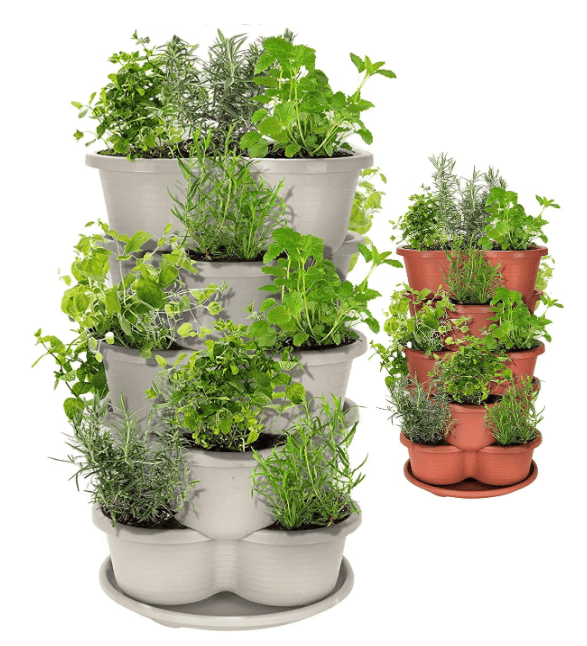
Vertical gardening is a great way to maximize this space. Amazon has this neat and inexpensive stackable garden tower that includes five tiers with 15 little spots for plants. It is only 24 inches tall, so you may want to put it on something to elevate it and rotate the tower every few days to make sure all the plants have access to sun.
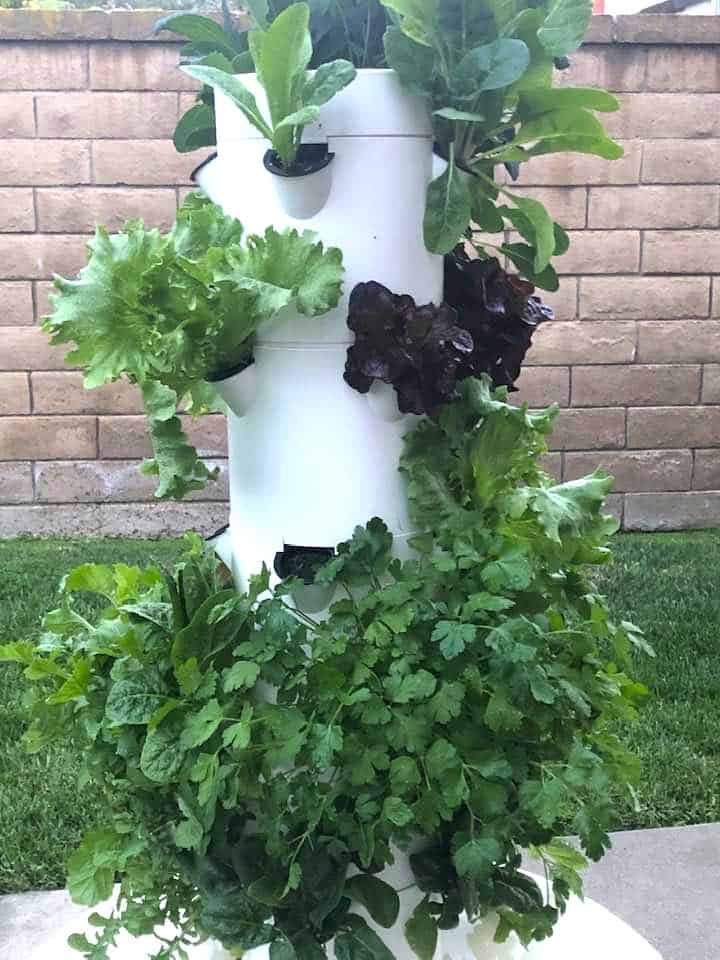
Another more expensive but overall better option is the Tower Garden. This gardening system uses hydroponics to grow a large amount of food in a small space. It reduces water usage by 95% in comparison to conventional gardening which is a big plus in drought-prone areas like California.
Using a self-watering sytem means that you won’t have to worry about watering your balcony vegetable garden every day and you can even be gone for a week and not have to worry about someone checking on your plants.
The Tower Garden is 62 inches high, and its water reservoir, which can hold 20 gallons of water, has a diameter of 30 inches. So it can fit in a space that is three feet square but since plants grow out of it, it is good to not place it right up against a wall.
I also suggest putting it on wheels (just buy a round planter base like this one at your local garden center) so that you can rotate the garden easily to distribute sunlight.
You will need access to electricity since this system uses a pump to move water up to the top of the Tower Garden. I have had my Tower Garden on my backyard patio for nearly a decade now and find that it is best for growing greens, peppers, strawberries, and herbs. You can buy an attachment cage to grow vining vegetables as well like tomatoes and cucumbers.
There is one major drawback to the Tower Garden. It is expensive. It is about $670 to buy the system which includes the tower, a pump, a variety of seeds, the rockwool which the seedling grow in, and the growing solutions which act as organic fertilizers for the plants. But, if you use it frequently, it will pay for itself in organic produce eventually.
Amazon sells a system that is similar to the Tower Garden but it is currently only $130. It is much smaller but the concept is the same. It does not include seeds or the nutrients but these are easy to purchas on Amazon as well.
The tower comes with everything you need for your first planting except for plants. Cups, sponge pods for planting seeds, and pump are all included. I have not personally used this system so I can’t vouch for it, but the reviews are good.
Replacement rockwool and hydroponic growing minerals can be purchased on Amazon and used with both systems. You will also want to check the PH of your water and adjust as needed to make sure your plants are growing in optimum conditions.
Self-Watering Raised Gardens
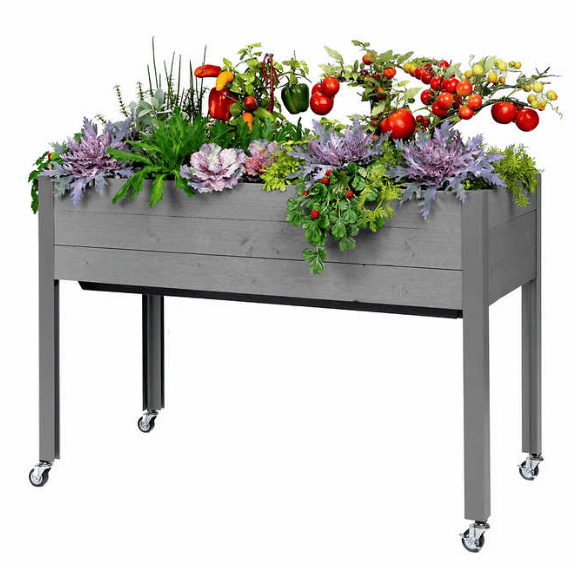
If you are like me and have a bad back, you know might want to have a raised garden on your balcony. I purchased this self-watering elevated planter from Costco last year and I have really liked growing things like lettuce, strawberries, peppers, and herbs in it.
I have found that newly planted crops with shallow roots don’t initially benefit from the self water feature so I do still have to water it regularly. Still, it is very easy to access and since it is on wheels, it is easy to move around.

Amazon has a variety of other options as well, including one garden that has multiple configuration options which will help you make the most of your balcony garden.
Self-Watering Drip Irrigation Kits

Of course, most balcony gardens have several different pots that will need to be watered, and daily watering can be a major pain. Using a solar powered irrigation system on a timer can be life changing. These are also great for when you go on vacation and don’t want to ask your neighbors to be plant babysitters.
13 Best Vegetables to Grow in a Balcony Garden
Even with limited space, you can enjoy a bountiful harvest by growing the right vegetables. These 13 veggies are compact, productive, and thrive in containers — perfect for small balconies and patios.
1. Lettuces

Why it’s great: Fast-growing and compact, lettuce is ideal for continuous harvests in small containers or vertical planters.
- Best types: Butterhead, romaine, red leaf
- Harvest: Baby greens in 3–4 weeks; full heads in 6–8 weeks
Lettuces are extremely easy to grow from seed and don’t take up much space, making them perfect for your balcony vegetable garden.
The key to always having lettuce for your salad is to sow seeds in succession. This means you plant seeds about 10-20 days apart to ensure you plants mature at different rates.
Some of my favorite lettuces to grow in small spaces are butterhead lettuce, red leaf lettuce, and romaine. Keep in mind that lettucess are generally not heat tolerant and do best when the weather is below 90 degrees. Their happy place is when highs are in the 60s and 70s.
2. Swiss Chard
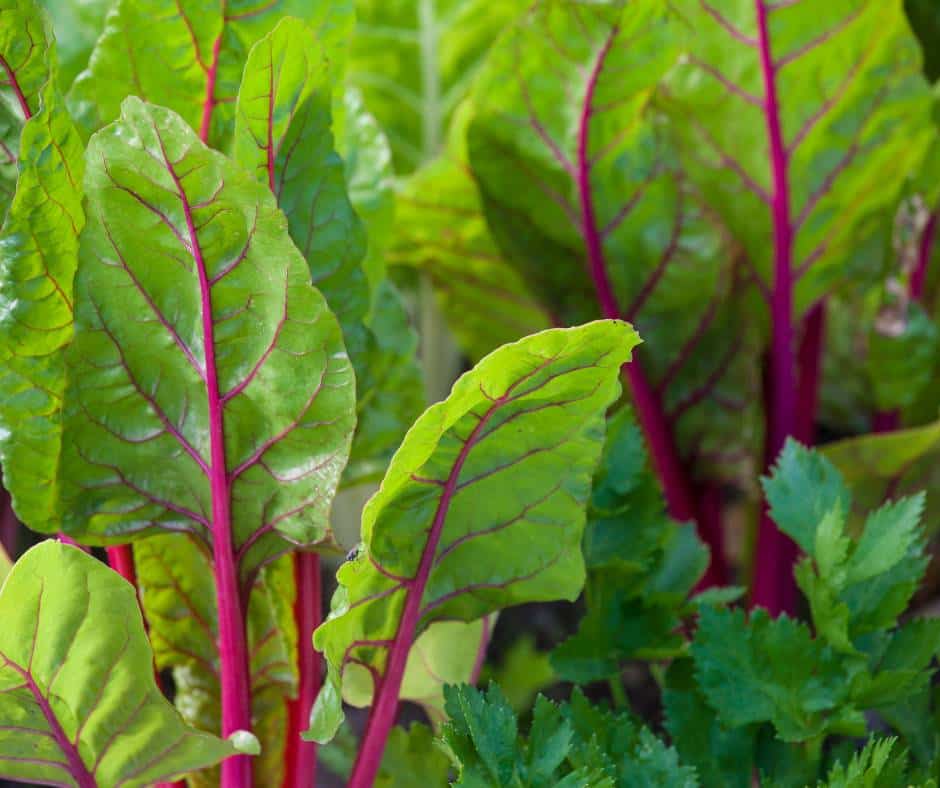
Why it’s great: Colorful, heat-tolerant, and productive, chard can be harvested continuously all season.
- Best types: Rainbow or Bright Lights varieties
- Harvest: Baby leaves in 4–6 weeks; full size in 10–12 weeks
Swiss chard is a hearty green that can stand up well to cooking and provides plenty of nutrition. Chopping this vegetable up and adding it to soups, stir fries, casseroles, and pasta dishes like lasagna is a great way to make the dish more healthy.
Chard can be grown in containers, making it suitable for small spaces like balconies. It also pairs well with other vegetables like beans, peas, tomatoes, and herbs in your garden.
Choose a container that is at least 12 inches deep to allow for proper root development. Chard leaves can be harvested as baby greens or allowed to reach full size. Pick the outer leaves regularly to encourage new growth. You can continue harvesting from the same plant throughout the growing season.
Growing Swiss chard from seed is very easy. First soak your seeds in water for 15 minutes immediately before sowing. Then, plant your seeds ½ inch below the soil. Germination takes one to two weeks and is best done between 50 and 80 degrees. You will have mature plants in 10-12 weeks.
Regular Swiss chard is a good option but rainbow chard is a more beautiful addition to your garden. It produces plants with yellow, red, pink, and white stems.
3. Arugula

Why it’s great: This spicy green grows fast and regrows after cutting.
- Best in cool weather; plant in succession every 2 weeks
- Harvest: Ready in 3–5 weeks
Arugula is my favorite green to add to a salad. Technically an herb, it has this peppery, mustardy bite that brings more flavor to dishes. It is a welcome addition to pizzas, sandwiches, quiches, and pesto.
Arugula is incredibly easy to grow at home in your balcony garden, and if you grow it in two week successions, you will have a harvest all season long.
Seeds are easy to germinate and should be covered with just a quarter inch of soil. In just a week sprouts will begin to appear. Harvest your arugula when stems are about 2-3 inches tall which take will take about 4-6 weeks from seed planting. If you let arugula stems grow too big, they will get tougher and more bitter.
Arugula made our list of the best herbs to grow in Southern California.
4. Radishes
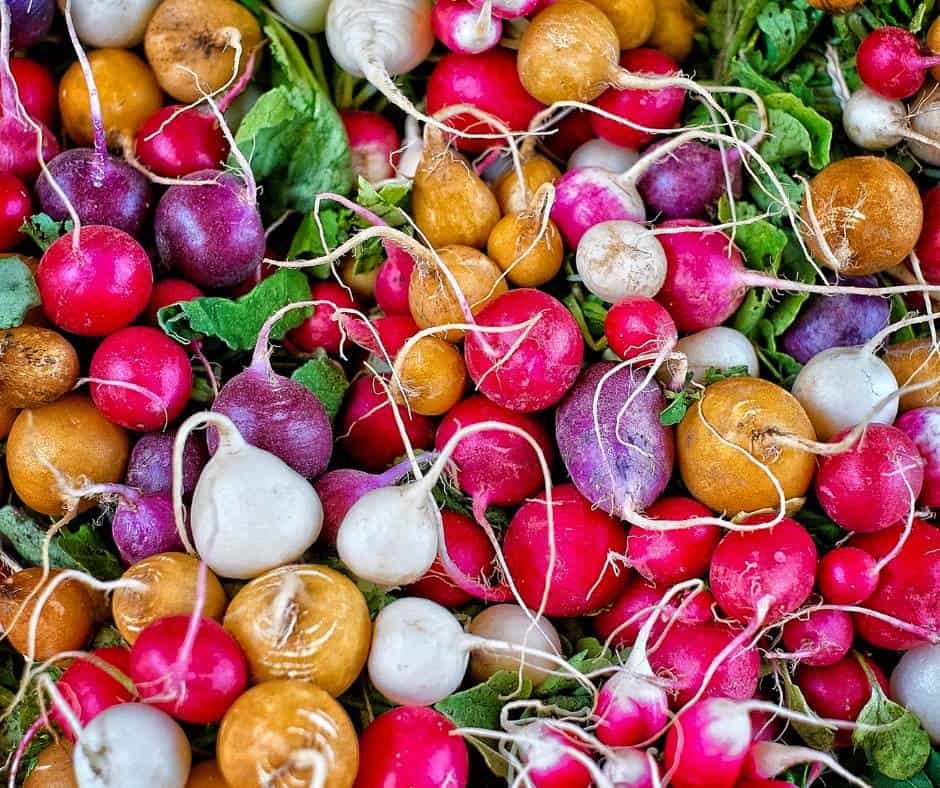
Why it’s great: One of the fastest veggies to grow — ideal for impatient gardeners!
- Best types: French Breakfast, Easter Egg mix, Cherry Belle
- Harvest: 20–30 days from seed
Radishes are one of the easiest things to grow in a balcony vegetable garden. They grow easily from seed, don’t take long to mature, and provide a nice bite when the bulbs are sliced in salads. You can even add their tops to salads as well.
Radishes do best in cooler weather (below 75) but a frost will kill them. They are best suited for summer and fall if you live in an area that does receive frost. You can plant seeds an inch apart and 1/2 deep. They can usually be harvested 3-5 weeks after planting.
Radishes come in such a beautiful variety of colors and shapes. I love the Baker Creek Heirloom Seeds Easter Basket Mix which contains about 15 varieties.
5. Tomatoes
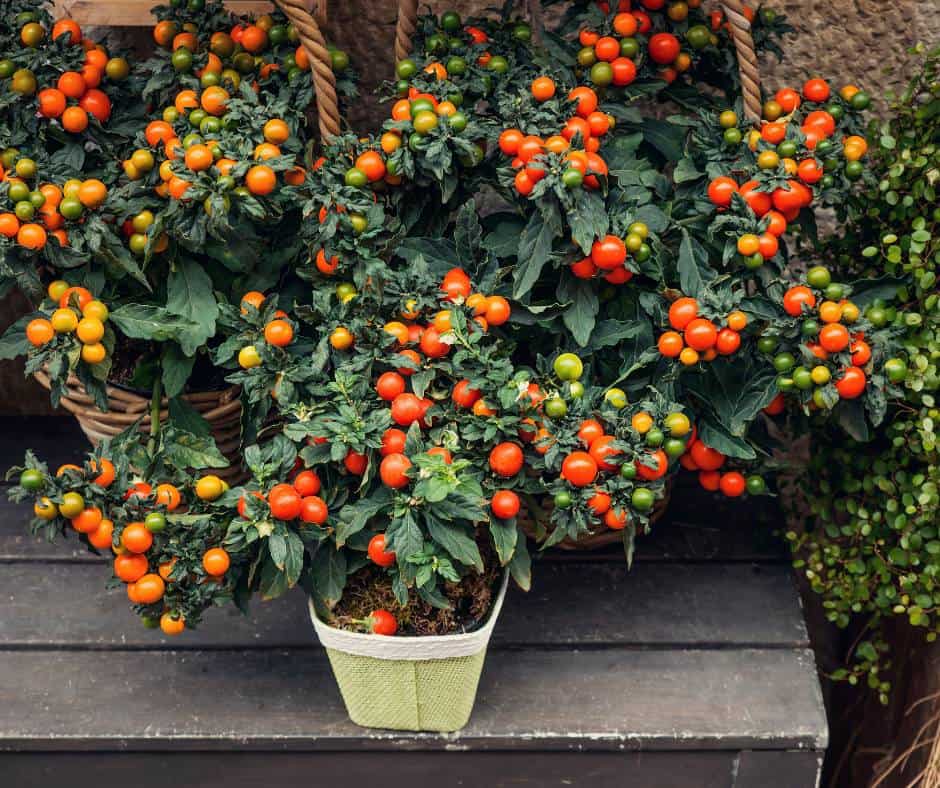
Why it’s great: Homegrown tomatoes taste amazing — and many compact varieties thrive in containers.
- Best types: Sungold, Better Bush, Bush Early Girl, Roma
- Harvest: 60–90 days, depending on variety
Tomatoes taste so much better when they are homegrown! The difference in flavor is truly remarkable. If you haven’t grown your own tomatoes before, make this year the year you do it!
Most tomatoes at the grocery store are picked when they are green to help them survive shipping and prolong shelf life. This does not allow the sun to sweeten the tomato and add more flavor. A homegrown tomato can be picked at peak ripeness, resulting in a much better tasting tomato.
It is important to pick the right tomatoes to grow in your balcony vegetable garden. Luckily, there are several great options for small spaces. Tomatoes prefer hot weather and plenty of sun, so give them the sunniest spot on your balcony.
Many cherry and grape tomatoes varieties have been cultivated to grow well in containers. The most easily available as seedlings are Better Bush and Sungold, but check your local garden center to see what they have.
Bush Early Girl and Bush Beefsteak are nice options for containers and they produce more standard-size tomatoes that are great for slicing and salsa. If you are interested in making fresh sauces or canning, Roma tomatoes can be grown in containers as well.
Of course, tomato planting isn’t foolproof, but I have all the secrets to a bumper crop. Check out my article filled with tomato growing tips.
Running into problems with your tomatoes? Here is an article dedicated to tomato plant problems and how to fix them.
6. Kitchen Herbs
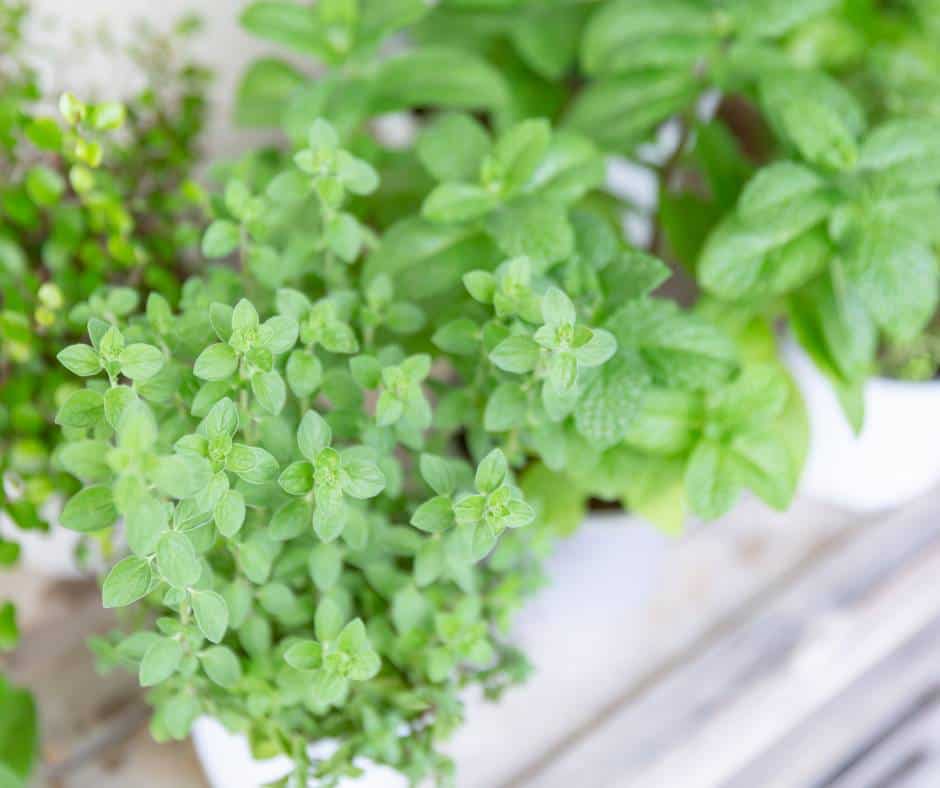
Why they’re great: Fresh flavor at your fingertips — and many herbs thrive in small pots.
- Best herbs: Basil, thyme, oregano, mint, parsley, cilantro
- Harvest: Ongoing; trim regularly to encourage new growth
No balcony vegetable garden is complete without some of the most common herbs used in the kitchen. Purchasing fresh herbs at the grocery store can be expensive but growing them is easy and they all tolerate small spaces.
I prefer to buy many of my kitchen herbs as seedlings from my local garden center. I always have basil, oregano, thyme, and sage on hand. They can all grow in the same space, though oregano can take over a pot easily, so be sure to keep it cut back or move it to its own small pot.
Cilantro and parsley are easy to grow from seed but they bolt quickly if it is warm, so I tend to only stick to cool season plantings.
I have a bay laurel plant on my patio so I always have bay leaves on hand. These small trees do well in a container. Rosemary is grown as a hedge in my area and many of my neighbors have it and are willing to share, so I skip it.
Mint is a plant that you should only grow in containers because it has a tendancy to take over a yard if given the chance. Your balcony garden can have several small pots filled with interesting mint varieties like chocolate pint, pineapple mint, and peppermint.
7. Upright Squash
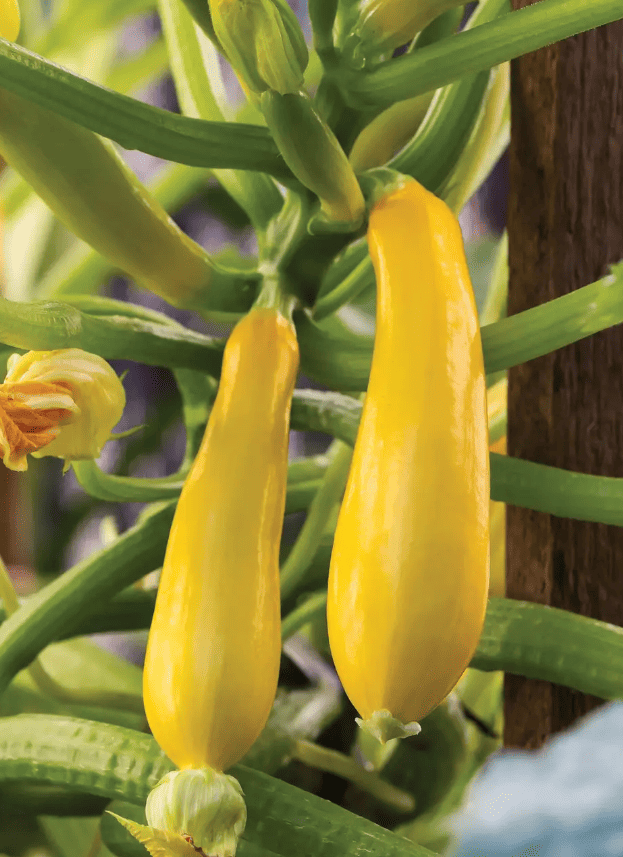
Why it’s great: New hybrid varieties like Burpee’s Rise & Shine grow vertically — perfect for small spaces.
- Harvest: 50–60 days
- Note: Requires pollination (hand pollination may be needed)
Summer squash grows like a weed in hot weather, but it also takes up quite a bit of space, so most people don’t grow them on their balconies. But recently, there was an exciting development in the world of squash…
Burpee is selling a Rise and Shine Hybrid summer squash which is essentially a yellow zucchini, and it grows upright! You will need to stake it like a tomato plant but when you do you will get a plant that can grow up to four feet high with a three-foot spread! That’s pretty compact! And the plant is quite prolific in its production, especially when the weather heats up.
Squash need pollinators like bees or other insects in order to transfer the pollen from the male flower to female flower. If you don’t have pollinators in your area, you will have to hand pollinate which is easy. Here is a great video explaining how to do it:
8. Cucumbers
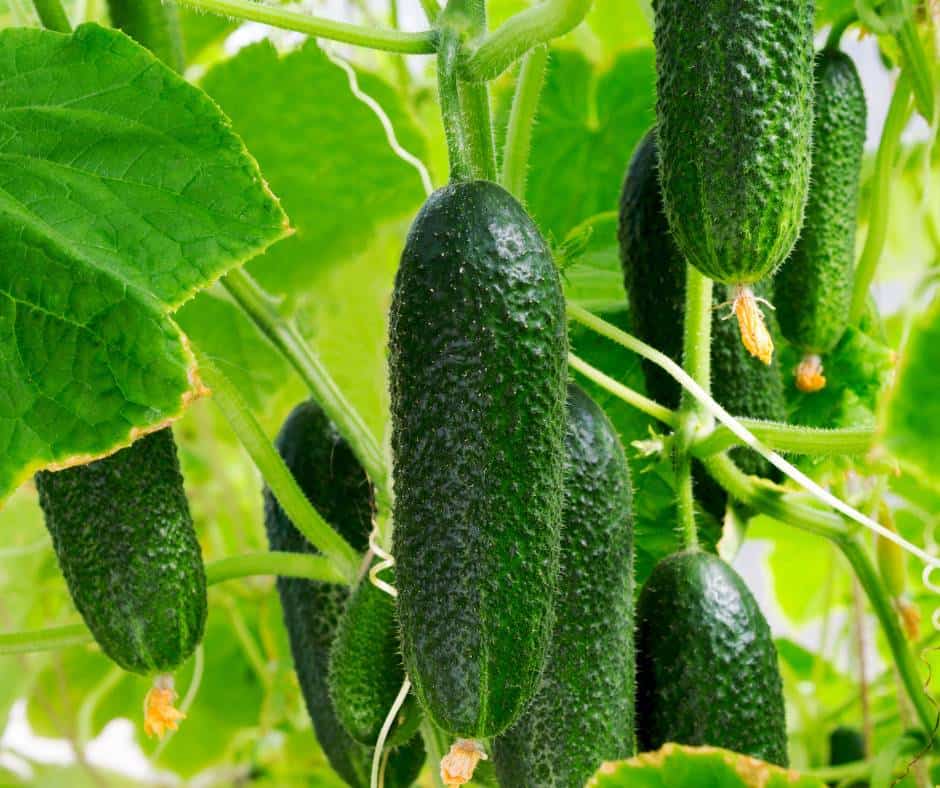
Why it’s great: Vining cucumbers are productive and climb well on trellises.
- Best types: Spacemaster, Patio Snacker, Lemon Cucumber
- Harvest: 50–70 days
Growing cucumbers in pots is a great option for those setting up a balcony garden, just be sure to put the plant in a pot that is 12-18 inches deep and wide to provide enough room for the cucumber plant to grow.
If starting from seeds, plant a few seeds about one inch deep in the center of the pot. Once they germinate, thin out the weakest seedlings, leaving only one or two plants. Or, take the easy route like I do, and purchase seedlings at the garden center.
Cucumbers are vining plants that benefit from vertical support. You will need to provide a trellis or a tomato cage for the plant to climb.
Cucumber plants do require pollination for fruit set. If you don’t have pollinators nearby, you will need to hand polinate like the squash plants (see above).
9. Peppers
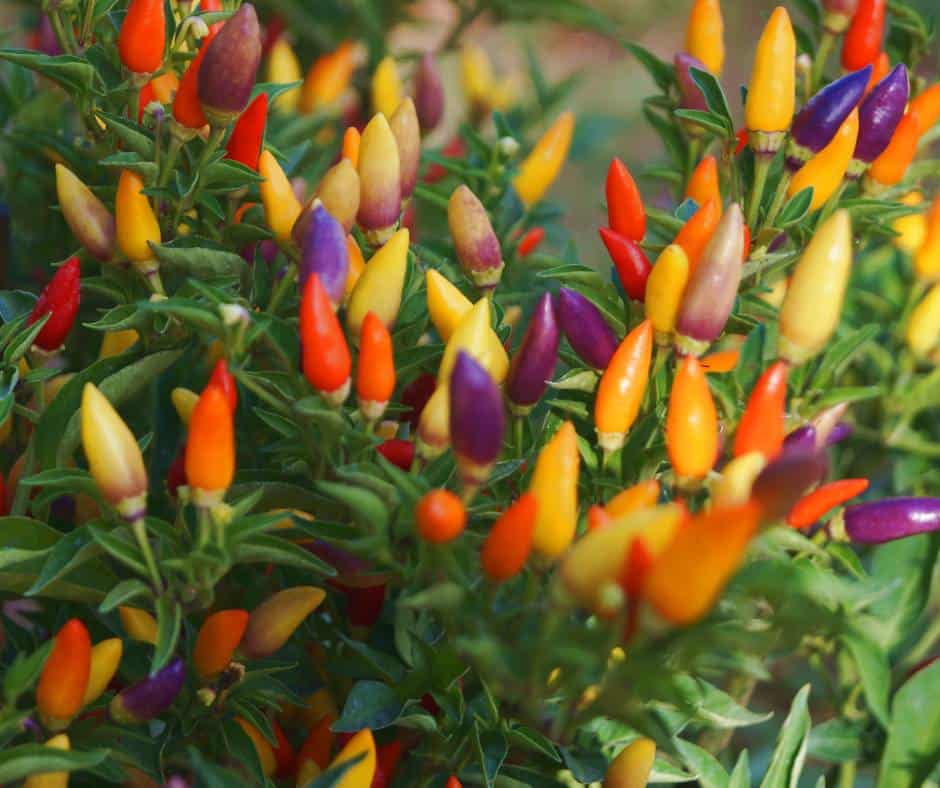
Why they’re great: Peppers love sun and grow very well in pots.
- Best types: Jalapeño, bell peppers, Anaheim, shishito
- Harvest: 60–90 days
I love growing peppers! There are thousands of pepper varieties available, each with its unique characteristics in terms of flavor, heat level, shape, size, and color.
I always plant jalapenos, a pepper for stuffing like Anaheim or pasillas, purple bell peppers because the are pretty and tasty, and shishito peppers which are great stir fried with oil and salt. I also try to plant a new-to-me variety each year.
Peppers are easy to grow in pots. They typically need a pot that is at least 12-16 inches in diameter and has drainage holes at the bottom so the roots don’t rot. Peppers love sun, but if temperatures got super hot, like above 90, it can burn them a bit so a little shade during heat waves can be a good thing.
10. Peas

Why they’re great: Cool-season crops that are fun to harvest and eat fresh.
- Best types: Tom Thumb (bush), Little Marvel, Sugar Pod
- Harvest: 50–70 days
Fresh peas are the best and you can enjoy them by growing them easily right on your balcony! All you need is a pot and a trellis (if you pick a vining variety). Choose a well-draining pot that is at least 12-18 inches deep and wide. Sow the pea seeds directly into the pot, planting the seeds about 1-2 inches deep.
Peas are typically ready for harvest around 60-70 days after planting, depending on the variety. Harvest the pods when they are plump and the peas inside have developed. Pick the pods regularly to encourage continuous production.
Tom Thumb is an extremely compact pea variety, reaching only 8-10 inches in height. It’s perfect for small pots and produces sweet, tender peas. Little Marvel is a popular dwarf variety that grows to about two feet in height. It produces a bounty of sweet and flavorful peas.
If you are looking to plant snap peas, Oregon Sugar Pod is a snap pea variety that grows to about three feet tall. It produces stringless, crisp pods that are delicious in stir-fries and salads.
11. Green Beans
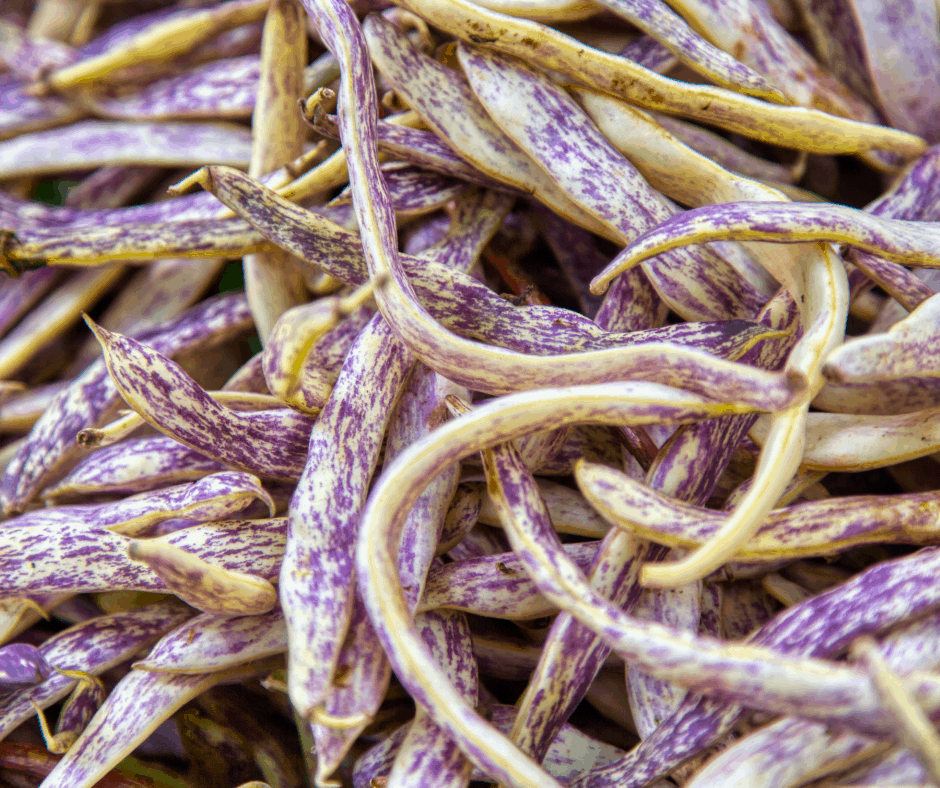
Why they’re great: Easy to grow and high yielding — especially pole beans with vertical support.
- Best types: Kentucky Wonder, Scarlet Runner, Dragon Tongue (bush)
- Harvest: 50–70 days
Growing pole beans in pots can be a rewarding experience because fresh green beans are tasty right off the vine. They are easy enough to grow in pots as long as you plant them in well-drained potting soil that is in a pot that is at least 12-18 inches in diameter and depth.
It is important to plant beans when soil is warm (minimum 60 degrees). They also need to be trellissed since pole beans are vining beans.
Kentucky Wonder is a heirloom variety is a classic pole bean with a rich flavor. It produces long, stringless pods and is known for its reliable yield. If you are looking for a show stopper, check out Scarlet Runner which is prized for its beautiful red flowers and edible pods. It’s a vigorous climber that adds visual appeal to the garden.
If you choose to plant a bush bean, I highly recommend the beautiful dragon tongue bean plant that has green pods that are striped with purple and has a delicate flavor.
12. Carrots
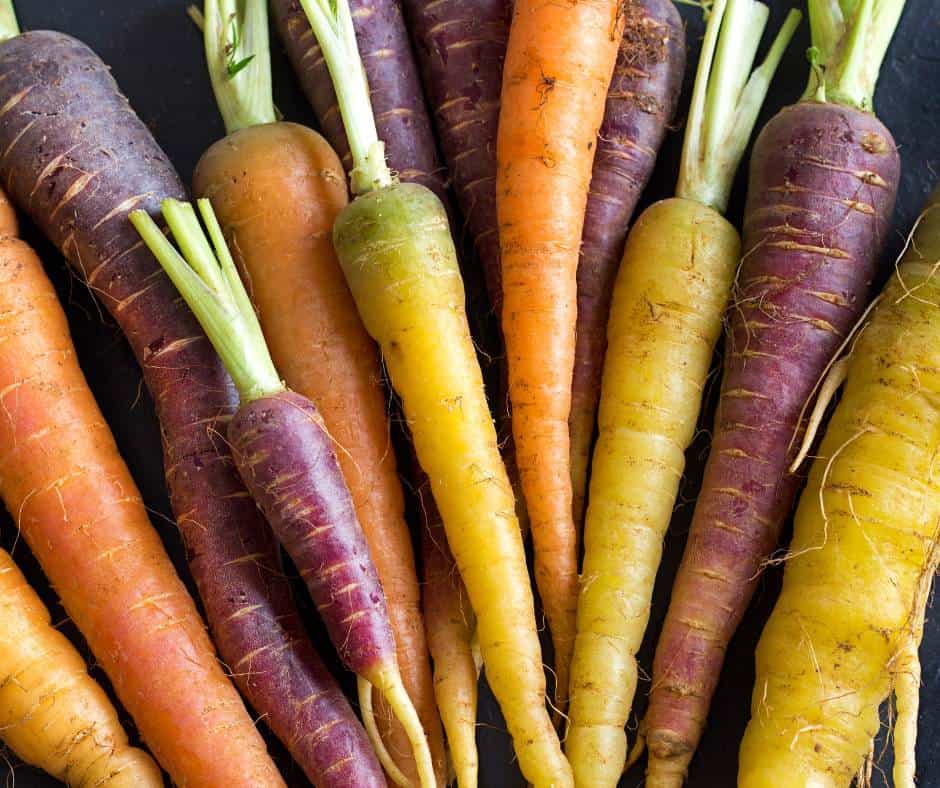
Why they’re great: Fun to grow and harvest — especially colorful heirloom varieties.
- Best types: Thumbelina, Paris Market, Cosmic Purple
- Container tip: Deep, loose soil; 8+ inch containers
- Harvest: 60–75 days
Carrots are a fun and easy vegetable to grow on a balcony. I like to grow my carrots in window boxes because they are deep enough to handle the carrot’s root but don’t take up too much room. Make sure your soil isn’t too dense- you want those roots to grow easily!
Carrots need regular watering, especially during dry spells, to prevent them from becoming tough or cracked. Water deeply to ensure that the moisture reaches the deeper roots. Using a drip water system is a good idea. They prefer cooler temperatures and are a great veggie to grow in the spring or fall.
Some carrot varieties that are well-suited for container gardening include Thumbelina, Paris Market, Little Finger, and Nantes. These varieties tend to be smaller in size, mature quickly, and have a good flavor. I like to grow varieties that aren’t easily found in grocery stores like Cosmic Purple.
13. Beets
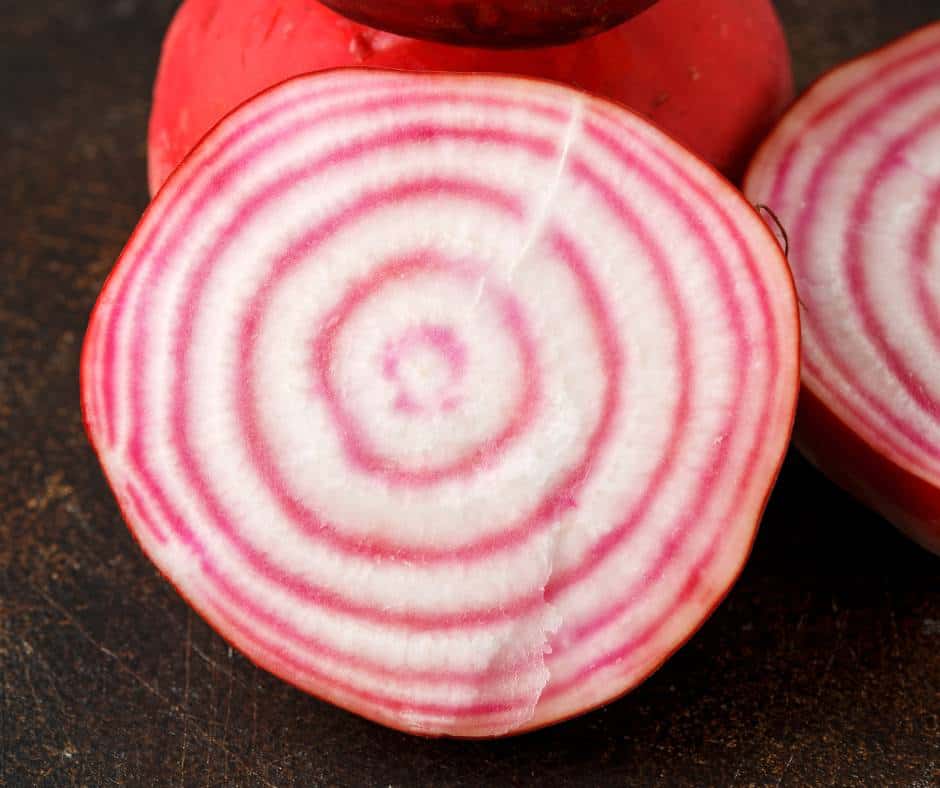
Why they’re great: Nutritious roots and edible greens — perfect for spring or fall.
- Best types: Detroit Dark Red, Chioggia, Cylindra
- Harvest: 55–70 days
Last but not least is the mighty beet. For many years, I was not a fan of beets. I thought they tasted like dirt. But I knew they were good for me so I persisted in trying them, and now they are one of my favorite vegetables!
Choose a container that is at least 8-10 inches deep to allow room for the beet roots to develop. The container should also have sufficient width to accommodate multiple beet plants. A rectangular or round container works well for growing beets.
You are better off sowing beet seeds directly into the container instead of trying to transfer seedlings. Scatter the seeds evenly over the moist soil surface, leaving about two inches of space between each seed and cover them with about a 1/2 inch of soil.
Beets like cooler temperatures and can tolerate some shade, especially in warmer climates, but at least 4-6 hours of sunlight daily is preferred. Beets are typically ready for harvest 55-70 days after sowing.
Beet varieties that are well-suited for container gardening include Babybeat, Bull’s Blood, Cylindra, and Detroit Dark Red. These varieties are known for their compact size, quick maturity, and good flavor. I also love chioggia beets because the red and white stripes are so lovely.
Common Mistakes to Avoid in a Balcony Vegetable Garden
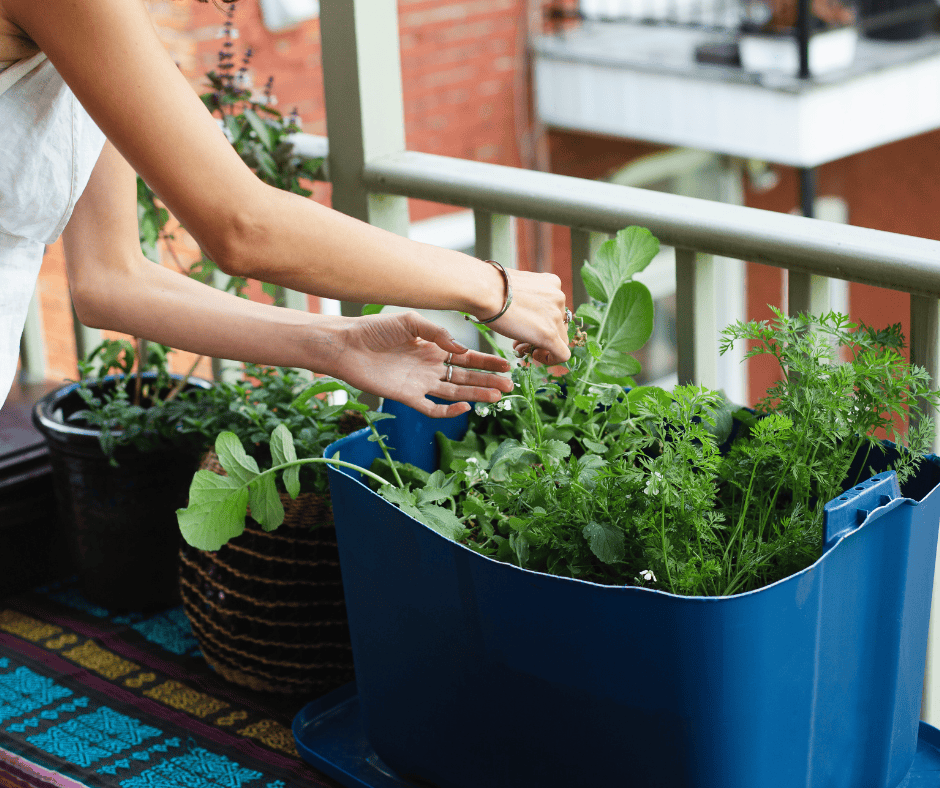
Even with limited space, balcony gardens can thrive—if you avoid these common pitfalls:
Overcrowding Plants
It’s tempting to grow everything, but too many plants in one pot compete for nutrients and sunlight. Stick to spacing guidelines and choose compact or dwarf varieties.
Poor Drainage
Always use pots with drainage holes. Without proper drainage, roots can rot, especially after heavy rain or frequent watering.
Not Matching Plants to Sunlight
Some vegetables need full sun (6+ hours), while others tolerate partial shade. Observe how much light your balcony gets and choose plants accordingly.
Ignoring Wind and Heat
Balconies often get more wind and radiant heat than ground-level gardens. Use windbreaks like mesh screens and mulch the soil to prevent water loss.
Skipping Fertilizer
Container gardens need more nutrients since watering flushes soil quickly. Use organic fertilizer regularly or add compost tea to boost growth.
Letting Pests Go Unchecked
Aphids, whiteflies, and spider mites can quickly take over small gardens. Inspect plants regularly and use organic insecticidal soap when needed.
Neglecting Watering Needs
Containers dry out faster, especially in hot weather. Install a drip irrigation system or self-watering pots to maintain consistent moisture levels.
Starting With the Wrong Season
Cool-weather crops like lettuce and peas don’t thrive in mid-summer heat. Always check the best planting season for each vegetable.
Tips for Growing More in Less Space
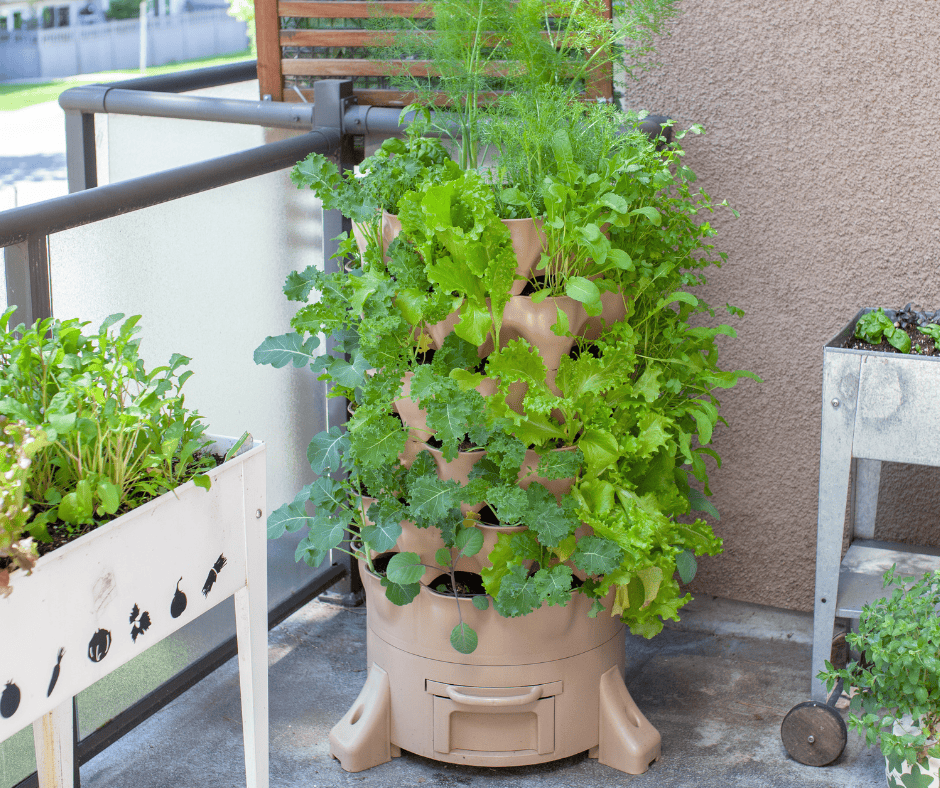
Even the smallest balcony can be transformed into a lush and productive vegetable garden with a few smart strategies. Here’s how to make the most of every inch:
| Strategy | How It Helps | Best For |
|---|---|---|
| Vertical Gardening | Maximizes space by growing up instead of out | Lettuce, strawberries, herbs, cucumbers |
| Compact/Dwarf Varieties | Grow full harvests in containers with minimal space | Tomatoes, carrots, peppers, green beans |
| Tiered/Modular Planters | Adds multiple levels of growing space in a single footprint | Leafy greens, compact root veggies |
| Companion Planting | Combines compatible crops in one container for mutual benefit | Tomatoes + basil, lettuce + carrots |
| Succession Planting | Extends harvest by staggering planting dates | Lettuce, radishes, peas, arugula |
| Maximize Sunlight | Boosts plant health by improving light access | All sun-loving vegetables |
| Self-Watering/Drip Systems | Saves time and ensures consistent moisture levels | All container vegetables |
| Railings & Wall Planters | Utilizes unused vertical space along balcony edges | Herbs, salad greens, flowers |
FAQ: Balcony Vegetable Gardening
Q: What vegetables grow best on a balcony?
A: Leafy greens like lettuce, spinach, and arugula grow well in containers, along with cherry tomatoes, peppers, herbs, and compact varieties of squash and cucumbers.
Q: How much sun do I need for a balcony vegetable garden?
A: Most vegetables need at least 6 hours of direct sunlight daily. South- or west-facing balconies tend to get the most sun. If your space gets less, stick with leafy greens and herbs that tolerate partial shade.
Q: Can I grow vegetables on a shady balcony?
A: Yes, some veggies like lettuce, Swiss chard, kale, parsley, and mint can thrive with as little as 3–4 hours of sun. Choose shade-tolerant varieties for best results.
Q: What containers are best for balcony gardening?
A: Use containers with good drainage that are at least 8–12 inches deep. Fabric grow bags, plastic pots, and self-watering planters all work well. Match container size to the plant’s root depth.
Q: How do I water a balcony vegetable garden?
A: Water regularly, as containers dry out quickly. Use a drip irrigation kit or self-watering system to maintain consistent moisture, especially in hot weather or while you’re away.
Q: Can I use regular garden soil in containers?
A: No, garden soil is too dense and may compact in pots. Use a high-quality potting mix or container-specific soil to ensure proper aeration and drainage.
Q: How do I fertilize container-grown vegetables?
A: Use an organic liquid fertilizer or slow-release pellets every few weeks, since nutrients deplete faster in containers than in-ground beds.
Q: Is it possible to grow root vegetables on a balcony?
A: Yes! Carrots, radishes, and beets grow well in containers that are deep enough — usually 10–12 inches. Choose compact or round-rooted varieties for the best results.
Q: What are the best vertical gardening solutions for balconies?
A: Stackable towers, wall planters, and trellised containers are excellent for vertical gardening. These options maximize limited space and work well for climbing plants like beans, peas, and cucumbers.

